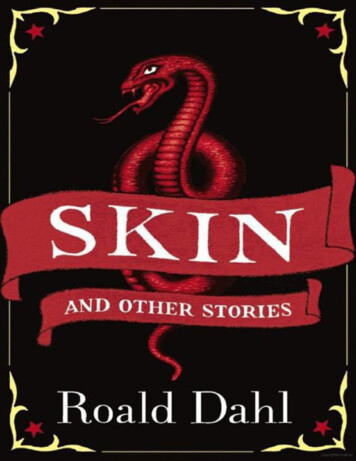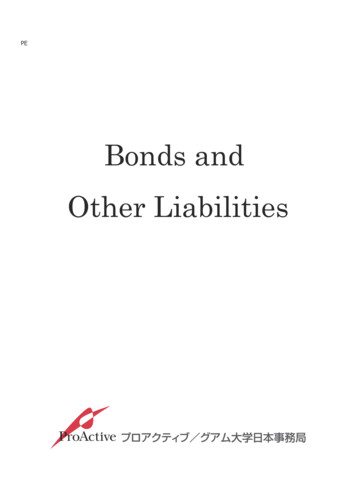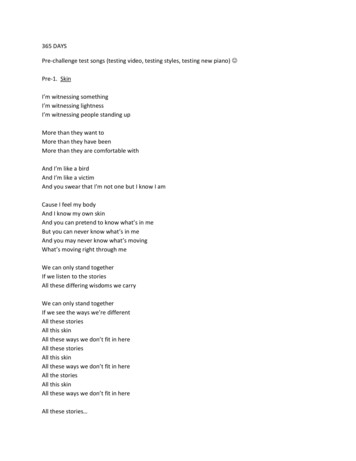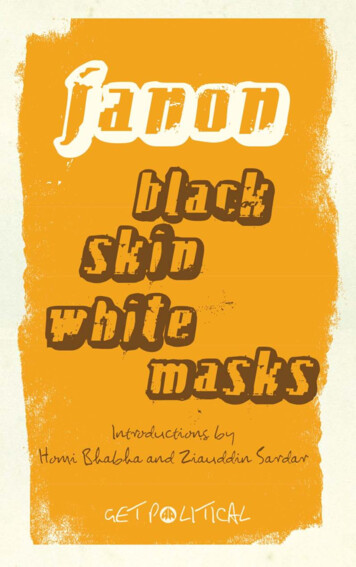
Transcription
ContentsIntroductionSkinLamb to the SlaughterThe Sound MachineAn African StoryGalloping FoxleyThe WishThe SurgeonDip in the PoolThe Champion of the WorldBeware of the DogMy Lady Love, My Dove
ABOUT ROALD DAHLRoald Dahl was born in 1916 in Wales of Norwegian parents. He was educated in England beforestarting work for the Shell Oil Company in Africa. He began writing after a ‘monumental bash on thehead’ sustained as an RAF fighter pilot during the Second World War. Roald Dahl is one of the mostsuccessful and well known of all children’s writers. His books, which are read by children the worldover, include James and the Giant Peach, Charlie and the Chocolate Factory, The Magic Finger,Charlie and the Great Glass Elevator, Fantastic Mr Fox, Matilda, The Twits, The BFG and TheWitches, winner of the 1983 Whitbread Award. Roald Dahl died in 1990 at the age of seventy-four.
IntroductionRoald Dahl, the writer and the man, needs no introduction – his autobiographies, Boy and GoingSolo, record, with considerable charm and with the skills of a storyteller, a life lived to the full.It is clear that being a reader was as important to Dahl as being a writer; his mother introduced himto The Wind in the Willows and the stories of Beatrix Potter and A. A. Milne. He was encouraged toread at school and had read the works of many classic writers, including Tolstoy and Balzac, by thetime he was twelve. The writers who influenced his own work were great storytellers such asSomerset Maugham, Rudyard Kipling and Damon Runyon and he became interested in writing storiesthat could be read in one sitting.Roald Dahl wanted to write accessible stories that would enable young people to share hispleasure for reading. He once said, ‘The success of a short story is simple, it must have a beginning, amiddle and an end. The reader must never want to put it down.’ Roald Dahl’s children’s books havethat un-put-downable quality that has made him the most popular writer for children today. Iremember reading an article about him somewhere that contained the memorable sentence, ‘Thepopularity of Roald Dahl is swelling like the giant peach.’ This continues to be true. Of course youngreaders love it when George describes his grandmother in George’s Marvellous Medicine as having‘pale brown teeth and a small puckered-up mouth like a dog’s bottom’, but most of all, they love thecharacters, the anarchy, the power of the stories and the element of surprise that is never missing forlong.Returning again to my hardback volume of Roald Dahl’s collected short stories for adults and thenlistening, with my fifteen-year-old niece, to some of them being read on the radio, I remember thatthey too have the magic of the children’s stories. They may be nastier, more shocking, darklyfascinating and even more unpredictable, but they certainly can’t be put down.Some of the stories in this book are technically brilliant and have appealed to many young adultreaders; they are a kind of bridge between the children’s stories and the clearly adult stories. Theytell of a woman who murders her husband with a leg of lamb, a sound machine that enables us to hearplants crying, a diamond’s journey, a man who has a great work of art tattooed on his back, and much,much more.The stories were written in New York, quite early in Roald Dahl’s writing career. Most of thechildren’s stories you will have enjoyed were written later in his famous refuge, the hut at the bottomof his garden. It was full of mementos – including one of his own arthritic hipbones – and it was hisplace. He wrote there in winter, wrapped in a blanket with his feet in a sleeping bag, and clearly hisimagination never felt the cold. These more grown-up stories will evoke a range of feelings andresponses; read them in your place and enjoy them.Wendy Cooling, 2000
BOOKS BY ROALD DAHLTHE BFGBOY: TALES OF CHILDHOODCHARLIE AND THE CHOCOLATE FACTORYCHARLIE AND THE GREAT GLASS ELEVATORDANNY THE CHAMPION OF THE WORLDGEORGE’S MARVELLOUS MEDICINEGOING SOLOJAMES AND THE GIANT PEACHMATILDATHE WITCHESFor younger readersTHE ENORMOUS CROCODILEESIO TROTFANTASTIC MR FOXTHE GIRAFFE AND THE PELLY AND METHE MAGIC FINGERTHE TWITSPicture booksDIRTY BEASTS (with Quentin Blake)THE ENORMOUS CROCODILE (with Quentin Blake)THE GIRAFFE AND THE PELLY AND ME (with Quentin Blake)THE MINPINS (with Patrick Benson)REVOLTING RHYMES (with Quentin Blake)PlaysTHE BFG: PLAYS FOR CHILDREN (Adapted by David Wood)CHARLIE AND THE CHOCOLATE FACTORY: A PLAY (Adapted by Richard George)DANNY THE CHAMPION OF THE WORLD: PLAYS FOR CHILDREN (Adapted by David Wood)FANTASTIC MR FOX: A PLAY (Adapted by Sally Reid)JAMES AND THE GIANT PEACH: A PLAY (Adapted by Richard George)THE TWITS: PLAYS FOR CHILDREN (Adapted by David Wood)THE WITCHES: PLAYS FOR CHILDREN (Adapted by David Wood)Teenage fictionTHE GREAT AUTOMATIC GRAMMATIZATOR AND OTHER STORIESRHYME STEWSKIN AND OTHER STORIESTHE VICAR OF NIBBLESWICKETHE WONDERFUL STORY OF HENRY SUGAR AND SIX MORECollectionsTHE ROALD DAHL TREASURYSONGS AND VERSE
SkinThat year – 1946 – winter was a long time going. Although it was April, a freezing wind blewthrough the streets of the city, and overhead the snow clouds moved across the sky.The old man who was called Drioli shuffled painfully along the sidewalk of the rue de Rivoli. Hewas cold and miserable, huddled up like a hedgehog in a filthy black coat, only his eyes and the top ofhis head visible above the turned-up collar.The door of a café opened and the faint whiff of roasting chicken brought a pain of yearning to thetop of his stomach. He moved on glancing without any interest at the things in the shop windows –perfume, silk ties and shirts, diamonds, porcelain, antique furniture, finely bound books. Then apicture gallery. He had always liked picture galleries. This one had a single canvas on display in thewindow. He stopped to look at it. He turned to go on. He checked, looked back; and now, suddenly,there came to him a slight uneasiness, a movement of the memory, a distant recollection of something,somewhere, he had seen before. He looked again. It was a landscape, a clump of trees leaning madlyover to one side as if blown by a tremendous wind, the sky swirling and twisting all around. Attachedto the frame there was a little plaque, and on this it said: CHAÏM SOUTINE (1894–1943).Drioli stared at the picture, wondering vaguely what there was about it that seemed familiar. Crazypainting, he thought. Very strange and crazy – but I like it Chaïm Soutine Soutine ‘By God!’he cried suddenly. ‘My little Kalmuck, that’s who it is! My little Kalmuck with a picture in the finestshop in Paris! Just imagine that!’The old man pressed his face closer to the window. He could remember the boy – yes, quiteclearly he could remember him. But when? The rest of it was not so easy to recollect. It was so longago. How long? Twenty – no, more like thirty years, wasn’t it? Wait a minute. Yes – it was the yearbefore the war, the first war, 1913. That was it. And this Soutine, this ugly little Kalmuck, a sullenbrooding boy whom he had liked – almost loved – for no reason at all that he could think of exceptthat he could paint.And how he could paint! It was coming back more clearly now – the street, the line of refuse cansalong the length of it, the rotten smell, the brown cats walking delicately over the refuse, and then thewomen, moist fat women sitting on the doorsteps with their feet upon the cobblestones of the street.Which street? Where was it the boy had lived?The Cité Falguière, that was it! The old man nodded his head several times, pleased to haveremembered the name. Then there was the studio with the single chair in it, and the filthy red couchthat the boy had used for sleeping; the drunken parties, the cheap white wine, the furious quarrels, andalways, always the bitter sullen face of the boy brooding over his work.It was odd, Drioli thought, how easily it all came back to him now, how each single smallremembered fact seemed instantly to remind him of another.There was that nonsense with the tattoo, for instance. Now, that was a mad thing if ever there wasone. How had it started? Ah, yes – he had got rich one day, that was it, and he had bought lots of
wine. He could see himself now as he entered the studio with the parcel of bottles under his arm – theboy sitting before the easel, and his (Drioli’s) own wife standing in the centre of the room, posing forher picture.‘Tonight we shall celebrate,’ he said. ‘We shall have a little celebration, us three.’‘What is it that we celebrate?’ the boy asked, without looking up. ‘Is it that you have decided todivorce your wife so she can marry me?’‘No,’ Drioli said. ‘We celebrate because today I have made a great sum of money with my work.’‘And I have made nothing. We can celebrate that also.’‘If you like.’ Drioli was standing by the table unwrapping the parcel. He felt tired and he wanted toget at the wine. Nine clients in one day was all very nice, but it could play hell with a man’s eyes. Hehad never done as many as nine before. Nine boozy soldiers – and the remarkable thing was that nofewer than seven of them had been able to pay in cash. This had made him extremely rich. But thework was terrible on the eyes. Drioli’s eyes were half closed from fatigue, the whites streaked withlittle connecting lines of red; and about an inch behind each eyeball there was a small concentrationof pain. But it was evening now and he was wealthy as a pig, and in the parcel there were threebottles – one for his wife, one for his friend, and one for him. He had found the corkscrew and wasdrawing the corks from the bottles, each making a small plop as it came out.The boy put down his brush. ‘Oh, Christ,’ he said. ‘How can one work with all this going on?’The girl came across the room to look at the painting. Drioli came over also, holding a bottle inone hand, a glass in the other.‘No,’ the boy shouted, blazing up suddenly. ‘Please – no!’ He snatched the canvas from the easeland stood it against the wall. But Drioli had seen it.‘I like it.’‘It’s terrible.’‘It’s marvellous. Like all the others that you do, it’s marvellous. I love them all.’‘The trouble is,’ the boy said, scowling, ‘that in themselves they are not nourishing. I cannot eatthem.’‘But still they are marvellous.’ Drioli handed him a tumblerful of the pale-yellow wine. ‘Drink it,’he said. ‘It will make you happy.’Never, he thought, had he known a more unhappy person, or one with a gloomier face. He hadspotted him in a café some seven months before, drinking alone, and because he had looked like aRussian or some sort of an Asiatic, Drioli had sat down at his table and talked.‘You are a Russian?’‘Yes.’‘Where from?’‘Minsk.’Drioli had jumped up and embraced him, crying that he too had been born in that city.‘It wasn’t actually Minsk,’ the boy had said. ‘But quite near.’‘Where?’‘Smilovichi, about twelve miles away.’
‘Smilovichi!’ Drioli had shouted, embracing him again. ‘I walked there several times when I was aboy.’ Then he had sat down again, staring affectionately at the other’s face. ‘You know,’ he had said,‘you don’t look like a western Russian. You’re like a Tartar, or a Kalmuck. You look exactly like aKalmuck.’Now, standing in the studio, Drioli looked again at the boy as he took the glass of wine and tippedit down his throat in one swallow. Yes, he did have a face like a Kalmuck – very broad and highcheeked, with a wide coarse nose. This broadness of the cheeks was accentuated by the ears whichstood out sharply from the head. And then he had the narrow eyes, the black hair, the thick sullenmouth of a Kalmuck, but the hands – the hands were always a surprise, so small and white like alady’s, with tiny thin fingers.‘Give me some more,’ the boy said. ‘If we are to celebrate then let us do it properly.’Drioli distributed the wine and sat himself on a chair. The boy sat on the old couch with Drioli’swife. The three bottles were placed on the floor between them.‘Tonight we shall drink as much as we possibly can,’ Drioli said. ‘I am exceptionally rich. I thinkperhaps I should go out now and buy some more bottles. How many shall I get?’‘Six more,’ the boy said. ‘Two for each.’‘Good. I shall go now and fetch them.’‘And I will help you.’In the nearest café Drioli bought six bottles of white wine, and then carried them back to the studio.They placed them on the floor in two rows, and Drioli fetched the corkscrew and pulled the corks, allsix of them; then they sat down again and continued to drink.‘It is only the very wealthy,’ Drioli said, ‘who can afford to celebrate in this manner.’‘That is true,’ the boy said. ‘Isn’t that true, Josie?’‘Of course.’‘How do you feel, Josie?’‘Fine.’‘Will you leave Drioli and marry me?’‘No.’‘Beautiful wine,’ Drioli said. ‘It is a privilege to drink it.’Slowly, methodically, they set about getting themselves drunk. The process was routine, but all thesame there was a certain ceremony to be observed, and a gravity to be maintained, and a great numberof things to be said, then said again – and the wine must be praised, and the slowness was importanttoo, so that there would be time to savour the three delicious stages of transition, especially (forDrioli) the one when he began to float and his feet did not really belong to him. That was the bestperiod of them all – when he could look down at his feet and they were so far away that he wouldwonder what crazy person they might belong to and why they were lying around on the floor like that,in the distance.After a while, he got up to switch on the light. He was surprised to see that the feet came with himwhen he did this, especially because he couldn’t feel them touching the ground. It gave him a pleasantsensation of walking on air. Then he began wandering around the room, peeking slyly at the canvases
stacked against the walls.‘Listen,’ he said at length. ‘I have an idea.’ He came across and stood before the couch, swayinggently. ‘Lis
readers; they are a kind of bridge between the children’s stories and the clearly adult stories. They tell of a woman who murders her husband with a leg of lamb, a sound machine that enables us to hear plants crying, a diamond’s journey, a man who has a great work of art tattooed on his back, and much, much more. The stories were written in New York, quite early in Roald Dahl’s writing .











